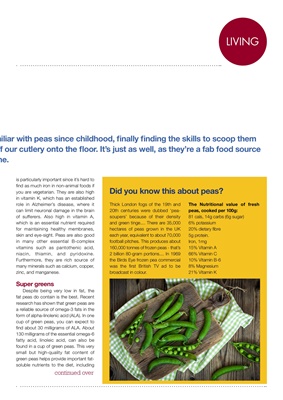
LIVING
iliar with peas since childhood, finally finding the skills to scoop them
f our cutlery onto the floor. It's just as well, as they're a fab food source
e.
continued over
Thick London fogs of the 19th and
20th centuries were dubbed 'peasoupers'
because of their density
and green tinge.... There are 35,000
hectares of peas grown in the UK
each year, equivalent to about 70,000
football pitches. This produces about
160,000 tonnes of frozen peas - that's
2 billion 80-gram portions.... In 1969
the Birds Eye frozen pea commercial
was the first British TV ad to be
broadcast in colour.
Did you know this about peas?
The Nutritional value of fresh
peas, cooked per 100g:
81 cals, 14g carbs (6g sugar)
6% potassium
20% dietary fibre
5g protein.
Iron, 1mg
15% Vitamin A
66% Vitamin C
10% Vitamin B-6
8% Magnesium
21% Vitamin K
is particularly important since it's hard to
find as much iron in non-animal foods if
you are vegetarian. They are also high
in vitamin K, which has an established
role in Alzheimer's disease, where it
can limit neuronal damage in the brain
of sufferers. Also high in vitamin A,
which is an essential nutrient required
for maintaining healthy membranes,
skin and eye-sight. Peas are also good
in many other essential B-complex
vitamins such as pantothenic acid,
niacin, thiamin, and pyridoxine.
Furthermore, they are rich source of
many minerals such as calcium, copper,
zinc, and manganese.
Super greens
Despite being very low in fat, the
fat peas do contain is the best. Recent
research has shown that green peas are
a reliable source of omega-3 fats in the
form of alpha-linolenic acid (ALA). In one
cup of green peas, you can expect to
find about 30 milligrams of ALA. About
130 milligrams of the essential omega-6
fatty acid, linoleic acid, can also be
found in a cup of green peas. This very
small but high-quality fat content of
green peas helps provide important fatsoluble nutrients to the diet, including